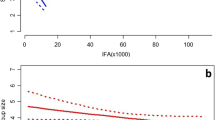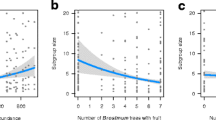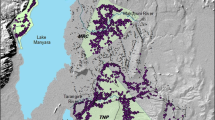Abstract
Species with greater expression of fission-fusion dynamics show greater variability in the size, composition, and cohesion of subgroups over time. This may allow their adjustment to local environmental, social, and demographic conditions. We tested which environmental and social factors influenced subgroup size in one such species, the black-and-white ruffed lemur (Varecia variegata) at two sites within a fragmented forest landscape. Using instantaneous focal sampling at 15-min intervals, we collected data on subgroup size and composition, fruit and flower availability, and location. We also collected biweekly data on site-wide fruit and flower availability. We used these data to test the influence of season, food availability, reproduction, and predation risk on adult subgroup size in this species. Ruffed lemur adults consistently formed significantly larger subgroups in times of lower site-wide fruit availability, during the wet season, and when one or more infants were present. There were differences between sites in the relationship between subgroup size and tree size, fruit patch size, and site-wide flower availability. Variables measuring indirect predation risk showed no significant relationship with subgroup size. These results emphasize the strong relationship between fission-fusion dynamics and spatial and temporal variation in food availability, as well as the importance of sociality in a species with communal care of infants. Fission-fusion dynamics may serve as an evolutionary strategy to adapt to the unpredictable and sometimes harsh environmental conditions of Madagascar and may facilitate the persistence of communities of this critically endangered lemur despite widespread anthropogenic habitat modification.
Significance statement
Fission-fusion dynamics (the joining and separating of subgroups within a larger group of animals) may allow species to adjust social benefits to changing environmental conditions. This study examines the underlying ecological and social factors that might influence fission-fusion dynamics in black-and-white ruffed lemurs. Subgroup size in this species was strongly related to food availability, though not always in the direction expected. This suggests that the relationship between food availability and sociality changes when food availability reaches very low levels. Additionally, infant presence was linked to larger adult subgroups, indicating a connection between fission-fusion behavior and the cooperative rearing of offspring seen in this species. Relationships between subgroup size and some environmental variables differed between sites, emphasizing the flexibility of grouping patterns in this species and indicating that local conditions may play a large role in the expression of fission-fusion dynamics.



Similar content being viewed by others

References
Abdi H (2010) Holm’s sequential bonferroni procedure. In: Salkind N, Dougherty DM, Frey B (eds) Encyclopedia of research design. Sage Publications Inc., Thousand Oaks, CA, pp. 573–577
Altmann J (1974) Observational study of behavior: sampling methods. Behaviour 49:227–267
Ansmann IC, Parra GJ, Chilvers BL, Lanyon JM (2012) Dolphins restructure social system after reduction of commercial fisheries. Anim Behav 84:575–581
Asensio N, Korstjens AH, Aureli F (2009) Fissioning minimizes ranging costs in spider monkeys: a multiple-level approach. Behav Ecol Sociobiol 63:649–659
Aureli F, Schaffner CM, Boesch C, et al. (2008) Fission-fusion dynamics new research frameworks. Curr Anthropol 49:627–654
Baden AL (2011) Communal infant care in black-and-white ruffed lemurs (Varecia variegata). PhD dissertation, Stony Brook University
Baden AL, Wright PC, Louis EE, Bradley BJ (2013) Communal nesting, kinship, and maternal success in a social primate. Behav Ecol Sociobiol 67:1939–1950
Baden AL, Webster TH, Kamilar JM (2016) Resource seasonality and reproduction predict fission-fusion dynamics in black-and-white ruffed lemurs (Varecia variegata). Am J Primatol 78:256–279
Balko EA (1998) A behaviorally plastic response to forest composition and logging disturbance by Varecia variegata variegata in Ranomafana National Park, Madagascar. PhD dissertation, State University of New York College of Environmental Science and Forestry
Balko EA, Underwood HB (2005) Effects of forest structure and composition on food availability for Varecia variegata at Ranomafana National Park, Madagascar. Am J Primatol 66:45–70
Bates LA, Byrne RW (2009) Sex differences in the movement patterns of free-ranging chimpanzees (Pan troglodytes schweinfurthii): foraging and border checking. Behav Ecol Sociobiol 64:247–255
Bates D, Maechler M, Bolker B, Walker S (2015) Fitting linear mixed-effects models using lme4. J Stat Softw 67:1–48
Bercovitch FB, Berry PSM (2010) Ecological determinants of herd size in the Thornicroft’s giraffe of Zambia. Afr J Ecol 48:962–971
Body G, Weladji RB, Holand O, Nieminen M (2015) Fission-fusion group dynamics in reindeer reveal an increase of cohesiveness at the beginning of the peak rut. Acta Ethol 18:101–110
Britt A (2000) Diet and feeding behaviour of the black-and-white ruffed lemur (Varecia variegata variegata) in the Betampona reserve, Eastern Madagascar. Folia Primatol 71:133–141
Brouwer L, Richardson DS, Komdeur J (2012) Helpers at the nest improve late-life offspring performance: evidence from a long-term study and a cross-foster experiment. PLoS One 7:e33167
Chapman CA, Chapman LJ, Wangham R, Hunt K, Gebo D, Gardner L (1992) Estimators of fruit abundance of tropical trees. Biotropica 24:527–531
Chapman CA, Wrangham RW, Chapman LJ (1995) Ecological constraints on group-size - an analysis of spider monkey and chimpanzee subgroups. Behav Ecol Sociobiol 36:59–70
Clutton-Brock TH, Russell AF, Sharpe LL, Brotherton PNM, McIlrath GM, White S, Cameron EZ (2001) Effects of helpers on juvenile development and survival in meerkats. Science 293:2446–2449
Coles RC, Lee PC, Talebi M (2012) Fission-fusion dynamics in southern muriquis (Brachyteles arachnoides) in continuous Brazilian Atlantic Forest. Int J Primatol 33:93–114
Davies NB, Krebs JR, West SA (2012) An introduction to behavioural ecology, 4th edn. Wiley, Chichester, UK
de Silva S, Ranjeewa ADG, Kryazhimskiy S (2011) The dynamics of social networks among female Asian elephants. BMC Ecol 11:17
Ebensperger LA, Rivera DS, Hayes LD (2012) Direct fitness of group living mammals varies with breeding strategy, climate and fitness estimates. J Anim Ecol 81:1013–1023
Ebensperger LA, Villegas A, Abades S, Hayes LD (2014) Mean ecological conditions modulate the effects of group living and communal rearing on offspring production and survival. Behav Ecol 25:862–870
ESRI (2012) ArcGIS Desktop. http://www.esri.com/software/arcgis/arcgis-for-desktop
Fennessy J (2004) Ecology of the desert-dwelling giraffe (Giraffa camelopardalis angolensis) in Northwestern Namibia. PhD dissertation, University of Sidney
Fishlock V, Lee PC (2013) Forest elephants: fission-fusion and social arenas. Anim Behav 85:357–363
Fleischmann D, Kerth G (2014) Roosting behavior and group decision making in 2 syntopic bat species with fission-fusion societies. Behav Ecol 25:1240–1247
Fortin D, Fortin ME, Beyer HL, Duchesne T, Courant S, Dancose K (2009) Group-size-mediated habitat selection and group fusion-fission dynamics of bison under predation risk. Ecology 90:2480–2490
Foster EA, Franks DW, Morrell LJ, Balcomb KC, Parsons KM, van Ginneken A, Croft DP (2012) Social network correlates of food availability in an endangered population of killer whales, Orcinus orca. Anim Behav 83:731–736
Ganzhorn JU (1989) Niche separation of 7 lemur species in the eastern rainforest of Madagascar. Oecologia 79:279–286
Gerber BD (2010) Madagascar GIS: spatial information to aid research and conservation. http://filebox.vt.edu/users/bgerber/services.htm. Accessed March 5, 2012
Google Inc (2009) Google Earth. https://www.google.ca/earth/download/ge/agree.html
Harper G, Steininger MK, Tucker CJ, Juhn D, Hawkins F (2007) Fifty years of deforestation and forest fragmentation in Madagascar. Environ Conserv 34:325–333
Hart LA, Grieve GRH, Downs CT (2013) Fruiting phenology and implications of fruit availability in the fragmented Ngele Forest Complex, KwaZulu-Natal, South Africa. S Afr J Bot 88:296–305
Hashimoto C, Furuichi T, Tashiro Y (2001) What factors affect the size of chimpanzee parties in the Kalinzu Forest, Uganda? Examination of fruit abundance and number of estrous females. Int J Primatol 22:947–959
Hashimoto C, Suzuki S, Takenoshita Y, Yamagiwa J, Basabose AK, Furuichi T (2003) How fruit abundance affects the chimpanzee party size: a comparison between four study sites. Primates 44:77–81
Henzi SP, Lusseau D, Weingrill T, van Schaik CP, Barrett L (2009) Cyclicity in the structure of female baboon social networks. Behav Ecol Sociobiol 63:1015–1021
Hijmans RJ, Cameron SE, Parra JL, Jones PG, Jarvis A (2005) Very high resolution interpolated climate surfaces for global land areas. Int J Climatol 25:1965–1978
Hodge SJ (2005) Helpers benefit offspring in both the short and long-term in the cooperatively breeding banded mongoose. Proc R Soc Lond B 272:2479–2484
Holm S (1979) A simple sequentially rejective multiple test procedure. Scand J Stat 6:65–70
Holmes SM (2012) Habitat use and population genetics of the black-and-white ruffed lemur (Varecia variegata) in a fragmented landscape in southeastern Madagascar, MA thesis, University of Calgary
Holmes SM, Baden AL, Brenneman RA, Engberg SE, Louis EE, Johnson SE (2013) Patch size and isolation influence genetic patterns in black-and-white ruffed lemur (Varecia variegata) populations. Conserv Genet 14:615–624
Holmes SM, Yaney-Keller AM, Rafidimanana DV, Andrianantenaina HM, Louis EE, Johnson SE (2015) Lemur population surveys in the Kianjavato region. Lemur News 19:9–11
Irwin MT, Raharison J, Raubenheimer D, Chapman CA, Rothman JM (2014) Nutritional correlates of the “lean season”: effects of seasonality and frugivory on the nutritional ecology of diademed sifakas. Am J Phys Anthropol 153:78–91
Itoh N, Nishida T (2007) Chimpanzee grouping patterns and food availability in Mahale Mountains National Park, Tanzania. Primates 48:87–96
Jaatinen K, Ost M, Lehikoinen A (2011) Adult predation risk drives shifts in parental care strategies: a long-term study. J Anim Ecol 80:49–56
Johnson SE (2002) Ecology and speciation in brown lemurs: white-collared lemurs (Eulemur albocollaris) and hybrids (Eulemur albocollaris x Eulemur fulvus rufus) in southeastern Madagascar. Dissertation, University of Texas at Austin
Karpanty SM (2003) Behavioral and ecological interactions of raptors and lemurs in southeastern Madagascar: a multiple predator approach. PhD dissertation, Stony Brook University
Karpanty SM (2006) Direct and indirect impacts of raptor predation on lemurs in southeastern Madagascar. Int J Primatol 27:239–261
Kerth G, Perony N, Schweitzer F (2011) Bats are able to maintain long-term social relationships despite the high fission-fusion dynamics of their groups. Proc R Soc Lond B 278:2761–2767
Legendre P, Legendre L (1998) Numerical Ecology, vol 20, 2nd edn. Elsevier Science & Technology, Burlington, MA, USA
Lehman SM, Rajaonson A, Day S (2006) Edge effects and their influence on lemur density and distribution in southeast Madagascar. Am J Phys Anthropol 129:232–241
Lehmann J, Boesch C (2004) To fission or to fusion: effects of community size on wild chimpanzee (Pan troglodytes verus) social organisation. Behav Ecol Sociobiol 56:207–216
Lehmann J, Korstjens AH, Dunbar RIM (2007) Fission-fusion social systems as a strategy for coping with ecological constraints: a primate case. Evol Ecol 21:613–634
Link A, Di Fiore A (2013) Effects of predation risk on the grouping patterns of white-bellied spider monkeys (Ateles belzebuth belzebuth) in western Amazonia. Am J Phys Anthropol 150:579–590
Lunardi DG, Ferreira RG (2014) Fission-fusion dynamics of Guiana dolphin (Sotalia guianensis) groups at Pipa Bay, Rio Grande do Norte, Brazil. Mar Mamm Sci 30:1401–1416
Morland HS (1990) Parental behavior and infant development in ruffed lemurs (Varecia-variegata) in a Northeast Madagascar rain-forest. Am J Primatol 20:253–265
Morland HS (1991) Social organization and ecology of black and white ruffed lemurs (Variecia variegata variegata) in lowland rain forest, Nosy Mangabe, Madagascar. PhD dissertation, Yale University
Murray CM, Lonsdorf EV, Stanton MA, Wellens KR, Miller JA, Goodall J, Pusey AE (2014) Early social exposure in wild chimpanzees: mothers with sons are more gregarious than mothers with daughters. P Natl Acad Sci USA 111:18189–18194
Newton-Fisher NE, Reynolds V, Plumptre AJ (2000) Food supply and chimpanzee (Pan troglodytes schweinfurthii) party size in the Budongo Forest Reserve, Uganda. Int J Primatol 21:613–628
Otali E, Gilchrist JS (2006) Why chimpanzee (Pan troglodytes schweinfurthii) mothers are less gregarious than nonmothers and males: the infant safety hypothesis. Behav Ecol Sociobiol 59:561–570
Overdorff DJ, Erhart EM, Mutschler T (2005) Does female dominance facilitate feeding priority in black-and-white ruffed lemurs (Varecia variegata) in southeastern Madagascar? Am J Primatol 66:7–22
Parra GJ, Corkeron PJ, Arnold P (2011) Grouping and fission-fusion dynamics in Australian snubfin and Indo-Pacific humpback dolphins. Anim Behav 82:1423–1433
Parrish JK, Edelstein-Keshet L (1999) Complexity, pattern, and evolutionary trade-offs in animal aggregation. Science 284:99–101
Pays O, Benhamou S, Helder R, Gerard JF (2007) The dynamics of group formation in large mammalian herbivores: an analysis in the European roe deer. Anim Behav 74:1429–1441
Pearson HC (2009) Influences on dusky dolphin (Lagenorhynchus obscurus) fission-fusion dynamics in Admiralty Bay, New Zealand. Behav Ecol Sociobiol 63:1437–1446
Pépin D, Gerard JF (2008) Group dynamics and local population density dependence of group size in the Pyrenean chamois, Rupicapra pyrenaica. Anim Behav 75:361–369
R Core Team (2015) R: a language and environment for statistical computing. R Foundation for Statistical Computing, Vienna, Austria. https://www.r-project.org
Raman TRS (1997) Factors influencing seasonal and monthly changes in the group size of chital or axis deer in southern India. J Biosciences 22:203–218
Ramos-Fernandez G, Morales JM (2014) Unraveling fission-fusion dynamics: how subgroup properties and dyadic interactions influence individual decisions. Behav Ecol Sociobiol 68:1225–1235
Ramos-Fernandez G, Boyer D, Aureli F, Vick LG (2009) Association networks in spider monkeys (Ateles geoffroyi. Behav Ecol Sociobiol 63:999–1013
Rasmussen DT (1985) A comparative study of breeding seasonality and litter size in 11 taxa of captive lemurs (Lemur and Varecia. Int J Primatol 6:501–517
Ratsimbazafy J (2002) On the brink of extinction and the process of recovery: responses of black-and-white ruffed lemurs (Varecia variegata variegata) to disturbance in Manombo Forest, Madagascar. PhD dissertation, State University of New York at Stony Brook
Ren BP, Li DY, Garber PA, Li M (2012) Fission-fusion behavior in Yunnan snub-nosed monkeys (Rhinopithecus bieti) in Yunnan, China. Int J Primatol 33:1096–1109
Ridley AR (2007) Factors affecting offspring survival and development in a cooperative bird: social, maternal and environmental effects. J Anim Ecol 76:750–760
Rimbach R, Link A, Montes-Rojas A, Di Fiore A, Heistermann M, Heymann EW (2014) Behavioral and physiological responses to fruit availability of spider monkeys ranging in a small forest fragment. Am J Primatol 76:1049–1061
Rubenstein DR (2011) Spatiotemporal environmental variation, risk aversion, and the evolution of cooperative breeding as a bet-hedging strategy. P Natl Acad Sci USA 108:10816–10822
Scantlebury M, Clutton-Brock TH, Speakman JR (2004) Energetics of cooperative breeding in meerkats Suricata suricatta. In: Morris S, Vosloo A (eds) Animals and environments. Elsevier Science, Amsterdam, pp. 367–374
Schaffner CM, Rebecchini L, Ramos-Fernandez G, Vick LG, Aureli F (2012) Spider monkeys (Ateles geoffroyi yucatenensis) cope with the negative consequences of hurricanes through changes in diet, activity budget, and fission-fusion dynamics. Int J Primatol 33:922–936
Schreier AL, Swedell L (2012) Ecology and sociality in a multilevel society: ecological determinants of spatial cohesion in hamadryas baboons. Am J Phys Anthropol 148:580–588
Silk JB (2007) The adaptive value of sociality in mammalian groups. Philos T Roy Soc B 362:539–559
Smith JE, Kolowski JM, Graham KE, Dawes SE, Holekamp KE (2008) Social and ecological determinants of fission-fusion dynamics in the spotted hyaena. Anim Behav 76:619–636
Snaith TV, Chapman CA (2007) Primate group size and interpreting sociolecological models: do folivores really play by different rules? Evol Anthropol 16:94–106
Sterck EHM, Watts DP, van Schaik CP (1997) The evolution of female social relationships in nonhuman primates. Behav Ecol Sociobiol 41:291–309
Sueur C, King AJ, Conradt L, Kerth G, Lusseau D, Mettke-Hofmann C, Schaffner CM, Williams L, Zinner D, Aureli F (2011) Collective decision-making and fission-fusion dynamics: a conceptual framework. Oikos 120:1608–1617
Sundaresan SR, Fischhoff IR, Dushoff J, Rubenstein DI (2007) Network metrics reveal differences in social organization between two fission-fusion species, Grevy’s zebra and onager. Oecologia 151:140–149
Symonds MRE, Moussalli A (2011) A brief guide to model selection, multimodel inference and model averaging in behavioural ecology using Akaike’s information criterion. Behav Ecol Sociobiol 65:13–21
Tilden CD, Oftedal OT (1997) Milk composition reflects pattern of maternal care in prosimian primates. Am J Primatol 41:195–211
Tutin CEG (1999) Fragmented living: behavioural ecology of primates in a forest fragment in the Lopé Reserve, Gabon. Primates 41:249–265
van Schaik CP (1999) The socioecology of fission-fusion sociality in orangutans. Primates 40:69–86
Vasey N (2007) The breeding system of wild red ruffed lemurs (Varecia rubra): a preliminary report. Primates 48:41–54
Wakefield ML (2008) Grouping patterns and competition among female Pan troglodytes schweinfurthii at Ngogo, Kibale National Park, Uganda. Int J Primatol 29:907–929
Wey TW, Burger JR, Ebensperger LA, Hayes LD (2013) Reproductive correlates of social network variation in plurally breeding degus (Octodon degus). Anim Behav 85:1407–1414
White AM, Cameron EZ (2011) Fitness consequences of maternal rearing strategies in warthogs: influence of group size and composition. J Zool 285:77–84
White FJ, Overdorff DJ, Balko EA, Wright PC (1995) Distribution of ruffed lemurs (Varecia-variegata) in Ranomafana National-Park, Madagascar. Folia Primatol 64:124–131
White AM, Cameron EZ, Peacock MM (2010) Grouping patterns in warthogs, Phacochoerus africanus: is communal care of young enough to explain sociality? Behaviour 147:1–18
Wittemyer G, Douglas-Hamilton I, Getz WM (2005) The socioecology of elephants: analysis of the processes creating multitiered social structures. Anim Behav 69:1357–1371
Wright PC (1999) Lemur traits and Madagascar ecology: coping with an island environment. Yearb Phys Anthropol 42:31–72
Wright PC, Razafindratsita VR, Pochron ST, Jernvall J (2005) The key to Madagascar frugivores. In: Dew JL, Boubli JP (eds) Tropical fruits and frugivores: the search for strong interactors. Springer, Dordrecht, pp. 121–138
Acknowledgments
We are grateful to Cressant Razafindravelo, Ferdinah Mbana, Jean Pierre Marolahy, Emilys Edgarçon Rakotoson, Gregor Pachmann, Melanie Vomscheid, Jean Samuelson Randrianarisoa, Jerrad Hayden, Sara Pearce Meijerink, Erin Moody, Jordon Traill, Eric Perlett, and Olivia Hanson for research assistance in Madagascar. We thank the BEAS editors and two anonymous reviewers for their comments on an earlier draft of this paper. We also thank the following organizations for funding: International Primatological Society, Omaha’s Henry Doorly Zoo and Aquarium, the Ahmanson Family Foundation, University at Albany, and the Natural Sciences and Engineering Research Council of Canada.
Author information
Authors and Affiliations
Corresponding author
Ethics declarations
Ethical approval
All applicable international, national, and/or institutional guidelines for the care and use of animals were followed.
Funding
Funding for this research was provided by the International Primatological Society, Omaha’s Henry Doorly Zoo and Aquarium, the Ahmanson Family Foundation, University at Albany, and the Natural Sciences and Engineering Research Council of Canada.
Informed consent
This study did not involve human participants.
Conflict of interest
The authors declare that they have no conflict of interest.
Additional information
Communicated by E. Huchard
Rights and permissions
About this article
Cite this article
Holmes, S.M., Gordon, A.D., Louis, E.E. et al. Fission-fusion dynamics in black-and-white ruffed lemurs may facilitate both feeding strategies and communal care of infants in a spatially and temporally variable environment. Behav Ecol Sociobiol 70, 1949–1960 (2016). https://doi.org/10.1007/s00265-016-2201-4
Received:
Revised:
Accepted:
Published:
Issue Date:
DOI: https://doi.org/10.1007/s00265-016-2201-4



